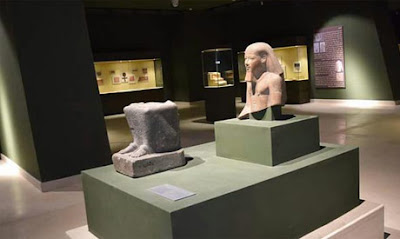It
seems that the curse of the Pharaohs that has hovered over the Sohag National
Museum for more than 29 years will finally be broken as the museum is set to
open its doors overlooking the Nile in the Upper Egyptian town of Sohag in the
coming days. Written By/ Nevine El-Aref.
Since
its launch in 1993, the museum has ground to a halt several times due to
disagreements over technical issues and interior design as well as over its
exhibits and a lack of funds after the 25 January Revolution. In 2016, work
resumed on the museum, and it is now scheduled to open next week.
The
museum is in the shape of a two-storey Ancient Egyptian temple overlooking the
Nile with a dock for ferries and exquisite landscaping dotted with water
channels and fountains. Five colossi of the lion goddess Sekhmet stand before
the museum’s entrance to welcome visitors.
“The
Sohag National Museum [SNM] is not just a regional museum that the Ministry of
Antiquities is opening in an Upper Egyptian province, but is part of the
country’s strategy to give attention and care to the Upper Egyptian
governorates and to develop their resources,” Minister of Antiquities Khaled
El-Enany told Al-Ahram Weekly. He
added that the completion of the museum was a dream come true and the result of
a promise by the ministry to Sohag and its inhabitants.
 Sohag
has rich archaeological sites from the early Ancient Egyptian era right up to
the Ptolemaic, Graeco-Roman, Coptic and Islamic periods. But although the
governorate contains many distinguished monuments and historical landmarks, it
is seldom visited.
Sohag
has rich archaeological sites from the early Ancient Egyptian era right up to
the Ptolemaic, Graeco-Roman, Coptic and Islamic periods. But although the
governorate contains many distinguished monuments and historical landmarks, it
is seldom visited.
To
promote the governorate’s archaeological sites and encourage tourists to pay a
visit to its monuments, El-Enany said the Ministry of Antiquities had been
accelerating efforts to complete the museum as a mirror reflecting Egypt’s
history. A comprehensive plan had been launched to develop sites in Sohag and
to make the area more tourist-friendly as well as to continue to preserve and
conserve them.
Elham
Salah, head of the Museum Sector at the Ministry of Antiquities, told the
Weekly that the aim of the museum was not only to reflect the unique history of
the governorate from pre-history to modern times, but also to highlight
Egyptian identity through the changes that had taken place in Upper Egypt.
The
exhibition scenario focuses on six influential aspects of Egyptian life
throughout the ages: kingship, the family, cooking and cuisine, faith and
religion, employment, industry and textiles and handicrafts.
 The
museum displays a collection of 945 artefacts, most of them unearthed in
different sites near Sohag and the rest having been carefully selected from the
Egyptian Museum in Tahrir Square in Cairo, the Museum of Islamic Art in Cairo’s
Bab Al-Khalq neighbourhood, the Textiles Museum in Al-Muizz Street in Historic
Cairo and the Coptic Museum in Old Cairo.
The
museum displays a collection of 945 artefacts, most of them unearthed in
different sites near Sohag and the rest having been carefully selected from the
Egyptian Museum in Tahrir Square in Cairo, the Museum of Islamic Art in Cairo’s
Bab Al-Khalq neighbourhood, the Textiles Museum in Al-Muizz Street in Historic
Cairo and the Coptic Museum in Old Cairo.
They
include clay pots with handles and small bases and a collection of jars and
painted clay lamps of different shapes and sizes. Also selected was a
collection of paintings showing scenes of a woman standing inside a domed
doorway and a man on the banks of the Nile. A small Persian manuscript relating
the traditional love story of Qays ibn Al-Mulawah and Layla in seventh-century
Arabia, known as Layla and Al-Majnun, is also among the selected objects and
features 18 coloured illustrations.
Pieces
of fabric decorated with faience ceramic beads, the remains of children’s linen
robes, and a rectangular piece of the Kiswa, the cloth draped over the Kaaba in
Mecca, are also in the collection. It is designed to display pieces that
represent the traditions, customs, industry and handicrafts of the area,
including traditional costumes and jewellery..... READ MORE.





No comments:
Post a Comment
Your feedback is important to us!
We invite all our readers to share with us their views and comments about this article.